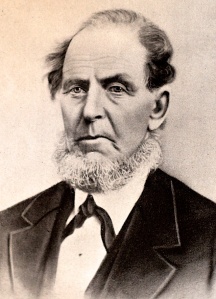As we make our way through the recently acquired vintage family photo album, we turn our attention to more unnamed faces. In this case, a boy and young man who could be the earlier faces of Henry Adam Treutel (1864-1962).

Henry Treutel was the third of seven children born to Philipp and Henrietta (Krosch) Treutel. The earliest confirmed photo of him in our collection shows him as a member of the Vesper Cornet Band, a local music group that performed around Wood County in the early 1900s. Other family-related members of the band included Charles Treutel and Orville Carlin.
Henry has a distinctive face and a somewhat different look than his siblings. Based on the shape of his face and his expression, we found two unidentified images that seem to fit him.

Henry Adam Treutel was born in Mukwonago, Wisconsin on October 5, 1864. He learned his blacksmithing and carpentry skills from his father Philipp in Mukwonago and Milwaukee. On October 11, 1900 in the village of Eagle, he married Josephine Adelia Garlach at the home of her parents, Constantine and Josephine Garlach. Shortly after, the couple moved with the rest of the Treutel family to Vesper in Wood County.
Almost immediately, Henry and Charles Treutel established Treutel Bros. blacksmith shop. They also sold Deering farm implements, and made and repaired wagons. Business was good, as evidenced by the large barn the brothers built on their property. Henry also secured construction of what the Grand Rapids Tribune described as “one of the most modern residences in Vesper.” Sadness filled the Treutel home on January 31, 1902, when Henry and Josephine’s firstborn child, Warren Mark Treutel, died at just 1 day old. Their second and only other child, Harold James Treutel, was born on September 2, 1903.

The Treutel Bros. excelled in music as well as business. “The Vesper people did not know there was a band in town until Wednesday evening, when the four Treutel Brothers came out and surprised the people by playing a few pieces,” the The Daily Tribune reported. “Come out again, boys.” It appears that Oscar and Walter Treutel joined their brothers in the performance, although I don’t believe Walter was part of the Cornet Band.
In 1917, Treutel Bros. expanded their facilities to add a large garage for the repair of automobiles. It later became a gasoline filling station, selling Red Crown fuel. Henry retired from the business in 1940.
Josephine Treutel died on June 14, 1955 in Wisconsin Rapids, where the couple moved in 1952 after retirement. Henry died on July 19, 1962 at age 97. The couple were survived by their son, Harold, daughter-in-law Genevieve (Senn) Treutel, and grandchildren Robert, Frederick, Barbara and Kathleen. A grandchild, Rose Marie, preceded them in death in January 1928.
©2017 The Hanneman Archive











































